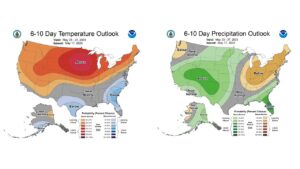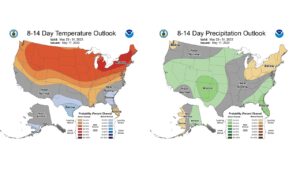Cool mornings and warm afternoons have made conditions pleasant across the state. Through the first 17 days of May, temperatures ran 1.5◦F above normal (Figure 1). Indiana Climate Divisions 1 and 7 had the largest departures, which were 2.1◦F and 2.0◦F above normal, respectively. Since April 1, growing degree days (GDD) have accumulated between 260 and 600 units statewide (Figure 2, left). Accumulations were above normal through the northern extent of the state and slightly below normal in the southern extent (Figure 2, right). However, since April 15, GDD accumulations have run between 10 and 60 units below normal statewide. This is attributed to the cooler conditions that occurred in the last half of April and beginning of May.
Statewide, precipitation ran 0.23 inches below normal through the first 17 days of May (Figure 1). Climate Divisions 1, 2, and 3, all located in northern Indiana, were the only areas with slightly above-normal precipitation. The rest of the state averaged 76 to 91 percent of normal precipitation. Most of the recent rains were a result of convective storms. Northern Indiana had two locations where rain exceeded four inches since April 18 (Figure 3). The Fort Wayne International Airport measured 5.05 inches and North Judson, located in Starke County, measured 8.05 inches total. On May 12-13, a line of storms developed along a frontal boundary and trained over northern Indiana. As a result, North Judson totaled 4.37 inches, triggering flood concerns in the area. The May 16 US Drought Monitor brought some improvement to the abnormally dry conditions in northwestern Indiana (Figure 4). Lingering drought concerns remained in Vermillion and Warren counties, as those locations continued to miss precipitation. Overall, conditions have favored continued agricultural activity. The May 14 Indiana Crop Weather Report indicated that 56 percent of corn and 52 percent of soybeans have been planted, which both are above the 5-year average. Emergence for both crops is also above the 5-year average as a result of the warmer temperatures.
The seven-day forecast precipitation blankets the state with less than 0.5 inches of rain, which should allow time to continue field work (Figure 5). That’s the good news. This also means that areas with below-normal precipitation will continue seeing subpar precipitation, which enhances drought concerns. Both the Climate Prediction Center’s 6–10-day (Figure 6) and 8-14-day (Figure 7) outlooks show elevated chances for above-normal temperatures and below-normal precipitation. Temperatures are forecasted to be in the upper 70s and low 80s, which should amplify drying conditions. Stay tuned to the US Drought Monitor over the next month, as conditions may worsen.
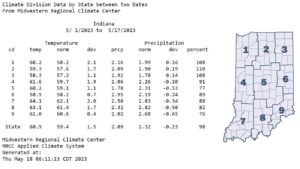
Figure 1. Indiana climate division and state temperature, normal temperature, temperature departure from normal, precipitation, normal precipitation, precipitation departure from normal, and percent of mean precipitation for May 1-17, 2023.
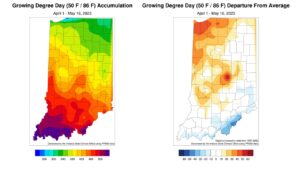
Figure 2. Total Accumulated Indiana Modified Growing Degree Days (MGDDs) April 1-May 16, 2023 (left) and Total Accumulated MGDDs represented as the departure from the 1991-2020 climatological normal (right).
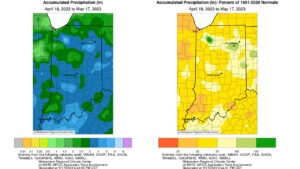
Figure 3. Interpolated map displaying accumulated precipitation for April 18-May 17, 2023 (left). Interpolated map displaying accumulated precipitation as a percent of the 1991-2020 climatological normal (right).
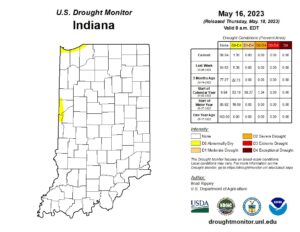
Figure 4. May 16, 2023, US Drought Monitor. The US Drought Monitor is released every Thursday morning by 8:30 AM.
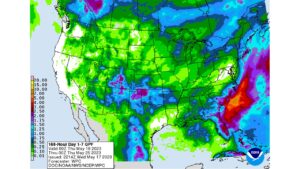
Figure 5. NWS Weather Prediction Center 7-day quantitative precipitation forecast for the continental United States, valid May 18-May 25, 2023.
